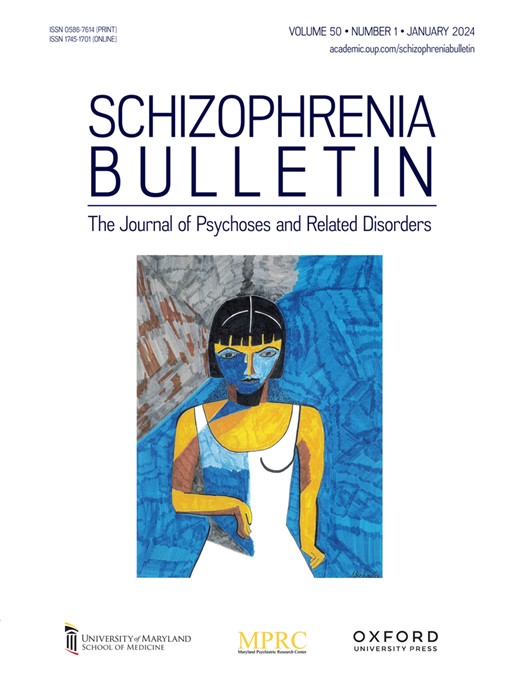精神分裂症的手势障碍:阴性症状和形式思维障碍的独特作用
IF 4.8
1区 医学
Q1 PSYCHIATRY
引用次数: 0
摘要
背景与假设手势障碍越来越被认为是精神分裂症的核心特征,在不同的领域和手势类别中都很明显。然而,特定症状域对不同类型手势的潜在差异影响尚不清楚。本研究旨在探讨阴性症状(NS)和形式思维障碍(FTD)的特定领域是否与精神分裂症患者手势表现的不同方面有关。研究设计使用上肢失用症测试来评估手势准确性,该测试测试了87名精神分裂症患者和57名年龄和性别匹配的对照组在2个领域和3个语义类别上的表现。此外,我们使用标准化的临床评定量表来评估NS和FTD在不同子领域的表现。研究结果:患者在两个领域和所有手势类别上的表现都比对照组差。此外,NS和FTD都与手势障碍有关,但这种联系是不同的。消极症状,特别是焦虑和情感扁平化,以及客观消极的FTD,与哑剧无意义手势的表现减少特别相关。相反,客观积极的FTD与更广泛的手势缺陷有关,影响模仿和哑剧领域,包括不及物手势和及物手势。结论:我们的研究结果表明,精神分裂症患者的手势障碍在不同的症状域存在差异,表明NS和FTD对运动和认知功能障碍的影响不同,暗示了不同的潜在神经机制。这些见解可以指导有针对性的干预措施,以解决基于潜在精神病理的特定手势缺陷。本文章由计算机程序翻译,如有差异,请以英文原文为准。
Gesture Impairments in Schizophrenia: Distinct Roles of Negative Symptoms and Formal Thought Disorder
Background and Hypothesis Gesture impairments are increasingly recognized as a core feature of schizophrenia, apparent across different domains and gesture categories. However, the potential differential effects of specific symptom domains on distinct types of gestures are unknown. The current study aimed to investigate whether specific domains of negative symptoms (NS) and formal thought disorder (FTD) relate to different aspects of gesture performance in patients with schizophrenia. Study Design Gesture accuracy was assessed using the well-established test of upper limb apraxia, which examines performance across 2 domains and 3 semantic categories in 87 patients with schizophrenia and 57 age- and gender-matched controls. Further, we used standardized clinical rating scales to assess NS and FTD across their different subdomains. Study Results Patients performed worse than controls in both domains and all gesture categories. Further, both NS and FTD were associated with gesture impairments, yet the associations were distinct. Negative symptoms, particularly avolition and affective flattening, as well as Objective Negative FTD, were specifically linked to reduced performance of pantomime meaningless gestures. Conversely, Objective Positive FTD was associated with a broader range of gesture deficits, impacting both imitation and pantomime domains, including intransitive and transitive gestures. Conclusions Our findings reveal that gesture impairments in schizophrenia vary across distinct symptom domains, indicating that NS and FTD contribute differently to motor and cognitive dysfunctions suggesting different underlying neural mechanisms. These insights can guide targeted interventions to address specific gesture deficits based on underlying psychopathology.
求助全文
通过发布文献求助,成功后即可免费获取论文全文。
去求助
来源期刊

Schizophrenia Bulletin
医学-精神病学
CiteScore
11.40
自引率
6.10%
发文量
163
审稿时长
4-8 weeks
期刊介绍:
Schizophrenia Bulletin seeks to review recent developments and empirically based hypotheses regarding the etiology and treatment of schizophrenia. We view the field as broad and deep, and will publish new knowledge ranging from the molecular basis to social and cultural factors. We will give new emphasis to translational reports which simultaneously highlight basic neurobiological mechanisms and clinical manifestations. Some of the Bulletin content is invited as special features or manuscripts organized as a theme by special guest editors. Most pages of the Bulletin are devoted to unsolicited manuscripts of high quality that report original data or where we can provide a special venue for a major study or workshop report. Supplement issues are sometimes provided for manuscripts reporting from a recent conference.
 求助内容:
求助内容: 应助结果提醒方式:
应助结果提醒方式:


